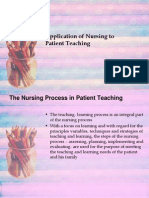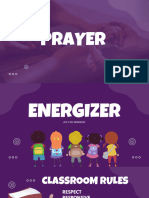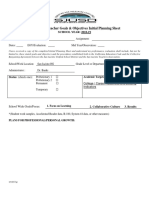100%(1)100% found this document useful (1 vote)
4K viewsClinical Teaching
Clinical Teaching
Uploaded by
Leigh Dela GuardiaClinical teaching is a complex process that requires careful planning and preparation. Educators must choose an appropriate clinical site, prepare the site staff, and set expectations for learners. During clinical sessions, educators conduct preconferences, observe learners' practice, and provide feedback. Multiple methods are used to evaluate learners, including self-evaluation, formal assessments, and conferences. Effective evaluation tools are clear, practical, valid, and measure objectives and competencies.
Copyright:
Attribution Non-Commercial (BY-NC)
Available Formats
Download as PPT, PDF, TXT or read online from Scribd
Clinical Teaching
Clinical Teaching
Uploaded by
Leigh Dela Guardia100%(1)100% found this document useful (1 vote)
4K views18 pagesClinical teaching is a complex process that requires careful planning and preparation. Educators must choose an appropriate clinical site, prepare the site staff, and set expectations for learners. During clinical sessions, educators conduct preconferences, observe learners' practice, and provide feedback. Multiple methods are used to evaluate learners, including self-evaluation, formal assessments, and conferences. Effective evaluation tools are clear, practical, valid, and measure objectives and competencies.
Original Title
Clinical Teaching Ppt
Copyright
© Attribution Non-Commercial (BY-NC)
Available Formats
PPT, PDF, TXT or read online from Scribd
Share this document
Did you find this document useful?
Is this content inappropriate?
Clinical teaching is a complex process that requires careful planning and preparation. Educators must choose an appropriate clinical site, prepare the site staff, and set expectations for learners. During clinical sessions, educators conduct preconferences, observe learners' practice, and provide feedback. Multiple methods are used to evaluate learners, including self-evaluation, formal assessments, and conferences. Effective evaluation tools are clear, practical, valid, and measure objectives and competencies.
Copyright:
Attribution Non-Commercial (BY-NC)
Available Formats
Download as PPT, PDF, TXT or read online from Scribd
Download as ppt, pdf, or txt
100%(1)100% found this document useful (1 vote)
4K views18 pagesClinical Teaching
Clinical Teaching
Uploaded by
Leigh Dela GuardiaClinical teaching is a complex process that requires careful planning and preparation. Educators must choose an appropriate clinical site, prepare the site staff, and set expectations for learners. During clinical sessions, educators conduct preconferences, observe learners' practice, and provide feedback. Multiple methods are used to evaluate learners, including self-evaluation, formal assessments, and conferences. Effective evaluation tools are clear, practical, valid, and measure objectives and competencies.
Copyright:
Attribution Non-Commercial (BY-NC)
Available Formats
Download as PPT, PDF, TXT or read online from Scribd
Download as ppt, pdf, or txt
You are on page 1of 18
By:
Dela Guardia, Leigh S.
Estellena, Maurice
Clinical teaching is a COMPLEX ENTERPRISE.
Clinical teaching is a time limited process
whereby teacher and student create an
established partnership within a shared
environment.
It is grounded in research but rather is
grounded in tradition, common sense, and
feasibility. (Barnard & Dunn, 1994;
Oermann,1996)
The severity of patient illness
Widely varying settings
Varied student motivation and preparation
It is in the laboratory that many skills are
perfected.
1. Skill of observation (Infante 1985)
2. Problem-solving and decision-making skills
(Fothergill-Bourbonnais & higushi, 1995)
3. Organization and Time-management skills
(Gabberson & Oermann,1999)
4. Cultural competence (Gabberson &
Oermann,1999)
Infante (1995)
• Developed a model that relies heavily on
keeping students in a skills laboratory
until they are proficient with skills.
Packer (1994)
▪ She contends that more information
about clinical practice should be taught
in the classroom before learners go to
the clinical area.
Hunsberger and colleagues (2000)
Clinical Teaching Associates (CTA) model is
designed for a two-day clinical experience.
▪ First day leads on with orientation to the unit and to the
clinical aasignment for a small group of students and the
educator. The CTA focuses heavily on PSYCHOMOTOR
SKILLS on that day. Both the CTA and the educators
attend and share leadership in the postconference.
▪ On the second day, the educator takes over the teaching
and supervisory role.
1. Purpose and expected outcomes of the clinical education of learners
2. Overview of the school curriculum as it relates to the clinical
experience
3. Skills that can be expected of learners entering the preceptorship
4. Principles of adult learning
5. Common errors made by students and common misconceptions
6. Roles and responsibilities of the preceptor, educator, and the
student
7. Interaction with learners and relationship with educators
8. Introduction to course syllabi
9. Planning learning experience
10. Clinical teaching strategies
11. Overview of evaluation procedures and measuring instruments
12. Legal implications of working with learners
To ensure positive learning experience for
learners, whether they are undergraduate
students, graduate students etc., and educators
must do a lot of planning before clinical
instruction begins.
Clinical agency site must be chosen
Once arrangements have been made for clinical
units, the educator should set up a meeting with
the agency staff that will involved with the
education process.
After these arrangements have been made, the
educator can proceed with the final preparation for
clinical instruction.
After all the careful preparation by educators
and learned, the clinical laboratory session
begins. For many instructors, the day starts
with a group preconference.
Preconference
▪ Learners usually share some of the results of their
research from the previous day.
▪ This is a good time to answer students’ questions about
their assignments and try to alleviate their anxieties.
Practice Session
▪ Following the preconference, the learners begin their
practice for the day.
▪ Learners may work closely with staff that answer many
routine questions and provide some assistance and
supervision....
Learners in the clinical area need the
feedback and judgement o their work that
evaluation gives them. They need to know
how they are doing at one level before
progressing to the next. Educators must
evaluate learners to determine how well they
are meeting objectives and to certify that
they are safe practitioners.
1. Choices to Be Made Regarding Evaluation
▪ Formative Evaluation
▪ Is the ongoing feedback given to the learner throughout the
learning experience.
▪ Summative Evaluation
▪ Is a summary evaluation given at the end of the learning
experience.
▪ Norm-referenced Evaluation
▪ A learner is compared with a reference group of learners either
those in the same cohort or in a norm group.
▪ Criterion-referenced Evaluation
▪ Compares the learner to well-defined performance criteria rather
than comparing him/her to other learners.
2. Behaviours to Be Evaluated
▪ Use of health promoting strategies
▪ Psychomotor skills
▪ Maintaining patient safety
▪ Ability to work with professional team
▪ Professional behaviours like following policies, being on
time, maintaining confidentiality, and being
accountable for one’s own action
3. Sources of Evaluation Data
▪ Self-evaluation
▪ Formal evaluation
▪ Written work submitted by the learner
4. Conferences Between Educator and
Learner
▪ The content of the conference is usually based on the
information in the anecdotal records and the rating
scales or summaries that are used
The instrument or tool used for clinical
evaluation should meet the following
specifications:
◦ The items should derive from the course or unit
objectives.
◦ The items must be measurable in some way. It must
be possible to collect substantial data.
◦ The items and instructions for use should be clear to
all that must use the tool.
◦ The tool should be practical in design and in length
◦ The toll must be valid and reliable (Carpenito &
Duespohl, 1981)
• Bondy (1983,1984) Rating Scale
• Bondy developed a five-point rating scale which
reflects criterion-referenced levels of competency.
• Hawranik (2000)
• Community Family Nursing Clinical Evaluation
Tool
• It contains items on the nursing process and professional
growth and leadership and could be used in evaluating
student in most home health settings.
• Clinical Evaluation Tool by Krichbaum and
colleagues
▪ Could be used in almost any clinical experience. It covers
items on health promotion, nursing process, safety,
scientific knowledge, multicultural care, therapeutic
relationships, professional behaviour.
You might also like
- Community Health A Complete Guide - 2020 EditionFrom EverandCommunity Health A Complete Guide - 2020 EditionRating: 5 out of 5 stars5/5 (1)
- Healthcare Reflections, Insights, and Lessons: Proactive/ReactiveFrom EverandHealthcare Reflections, Insights, and Lessons: Proactive/ReactiveNo ratings yet
- The Ethic of Care: A Moral Compass for Canadian Nursing Practice - Revised EditionFrom EverandThe Ethic of Care: A Moral Compass for Canadian Nursing Practice - Revised EditionNo ratings yet
- Chronic Non-communicable Diseases in Ghana: Multidisciplinary PerspectivesFrom EverandChronic Non-communicable Diseases in Ghana: Multidisciplinary PerspectivesNo ratings yet
- Basic Occupational Health Services A Complete Guide - 2020 EditionFrom EverandBasic Occupational Health Services A Complete Guide - 2020 EditionNo ratings yet
- The Antidote to Suffering: How Compassionate Connected Care Can Improve Safety, Quality, and ExperienceFrom EverandThe Antidote to Suffering: How Compassionate Connected Care Can Improve Safety, Quality, and ExperienceNo ratings yet
- Clinical TeachingDocument17 pagesClinical TeachingHassen ZabalaNo ratings yet
- Clinical TeachingDocument31 pagesClinical Teachingabcqwe123No ratings yet
- Purpose of Clinical TeachingDocument3 pagesPurpose of Clinical TeachingCharles kevin InesNo ratings yet
- Clinical Teaching Grp5 3y3-2Document77 pagesClinical Teaching Grp5 3y3-2Mariz Sherine P. EspinosaNo ratings yet
- Psycho Motor SkillsDocument9 pagesPsycho Motor Skillstimoetoamos123100% (1)
- Evaluate With The Client Outcomes of Health Education Competence Based On Learning NeedsDocument7 pagesEvaluate With The Client Outcomes of Health Education Competence Based On Learning NeedsJhovan ClydeNo ratings yet
- Evaluate With The Client Outcomes of Health Education Competence Based On Learning NeedsDocument7 pagesEvaluate With The Client Outcomes of Health Education Competence Based On Learning NeedsPrincess Dela CruzNo ratings yet
- NUR 420 Practicum Midterm Practicum Progress DocumentDocument9 pagesNUR 420 Practicum Midterm Practicum Progress DocumentBrooke GagnonNo ratings yet
- Determinants of LearningDocument3 pagesDeterminants of LearningAlly AbadeoNo ratings yet
- Health Ed 2NDDocument31 pagesHealth Ed 2NDclaribel100% (1)
- Teaching & Learning in Nursing NGU 5401Document25 pagesTeaching & Learning in Nursing NGU 5401lasantha buddhika100% (1)
- Pt. 1 ASL 1 SY 24 25Document23 pagesPt. 1 ASL 1 SY 24 25hiimleoNo ratings yet
- Principles of Teaching and Learning Related To Health Education 2019-2020Document106 pagesPrinciples of Teaching and Learning Related To Health Education 2019-2020Lyssa Marie Ege100% (2)
- SHS 423 Lec 08Document37 pagesSHS 423 Lec 08MAELEEHA JAVEDNo ratings yet
- Lecture Notes NCM 119Document23 pagesLecture Notes NCM 119Angelie PantajoNo ratings yet
- NUR 420 Practicum Final Practicum Progress DocumentDocument7 pagesNUR 420 Practicum Final Practicum Progress DocumentBrooke GagnonNo ratings yet
- Health Educ - Notes FinalsDocument260 pagesHealth Educ - Notes FinalsMary Jane TiangsonNo ratings yet
- Chapter 4 Components of Special and Inclusive EducationDocument82 pagesChapter 4 Components of Special and Inclusive EducationKyla JadjurieNo ratings yet
- Quality ControlDocument5 pagesQuality ControlCheran DeviNo ratings yet
- Clinical TeachingDocument28 pagesClinical TeachingAnthony Riggs100% (1)
- Strat Power PointDocument49 pagesStrat Power PointRhod Bernaldez EstaNo ratings yet
- Perspective On Teaching and LearningDocument72 pagesPerspective On Teaching and LearningJamesBuensalidoDellava100% (2)
- Educational Assessment HandoutDocument6 pagesEducational Assessment Handoutrupali gahalianNo ratings yet
- Determinants of Learning 22-23 1 PDFDocument70 pagesDeterminants of Learning 22-23 1 PDFA Dummy's AngleNo ratings yet
- Instructional DecisionDocument13 pagesInstructional DecisionGlennson LoyolaNo ratings yet
- Clinical TeachingDocument28 pagesClinical TeachingAnonymous dsEEFHocNo ratings yet
- Components of Special Inclusive EducationDocument24 pagesComponents of Special Inclusive EducationelaizanambatacNo ratings yet
- Educ 4. Assessment in Learning. Unit 1Document73 pagesEduc 4. Assessment in Learning. Unit 1Jake GopitaNo ratings yet
- ASSESSMENTDocument5 pagesASSESSMENTKieth RosalNo ratings yet
- Assessment Guidelines Under The New Normal Powerpoint PResentationDocument62 pagesAssessment Guidelines Under The New Normal Powerpoint PResentationDante Maligsa Bautista100% (1)
- Group 3 Reporters FinalDocument29 pagesGroup 3 Reporters FinalKim JezrahNo ratings yet
- Preliminary Concepts and Recent Trends: Lesson 1. What Is Educational Assessment?Document20 pagesPreliminary Concepts and Recent Trends: Lesson 1. What Is Educational Assessment?Sunshine Arceo100% (7)
- Clinical Teaching Methods: 1.formulating ObjectivesDocument6 pagesClinical Teaching Methods: 1.formulating ObjectivesAnuchithra Radhakrishnan88% (8)
- Chapter 4 Educ Report PPT and Reporters PartsDocument11 pagesChapter 4 Educ Report PPT and Reporters PartsAriella BeaufortNo ratings yet
- EVALUATION 4th Yr Full UnitDocument241 pagesEVALUATION 4th Yr Full UnitStephy SojanNo ratings yet
- Interim Guidelines For Assesment Under The New Normal: DEPED ORDER No. 31 S. 2020Document62 pagesInterim Guidelines For Assesment Under The New Normal: DEPED ORDER No. 31 S. 2020xanne92% (50)
- EvaluationDocument45 pagesEvaluationkiwandaemmanuel21No ratings yet
- Assessment in Learning 1Document36 pagesAssessment in Learning 1Joel Phillip Granada100% (1)
- The Three Dimensions of SupervisionDocument3 pagesThe Three Dimensions of Supervisionjasna hussainNo ratings yet
- Acob M 7 CurrAsmt Mar6Document9 pagesAcob M 7 CurrAsmt Mar6Joy AcobNo ratings yet
- Goals and Objectives 2018Document6 pagesGoals and Objectives 2018api-463660417No ratings yet
- Clinicalteachingmethods 180306040756Document31 pagesClinicalteachingmethods 180306040756abcqwe123No ratings yet
- Post Anesthesia Care UnitDocument10 pagesPost Anesthesia Care UnitMaria Criselda C. CelonNo ratings yet
- Lesson 1Document27 pagesLesson 1arevalodal.psaueskwela.edu.phNo ratings yet
- DEBATE Priti NSG EducationDocument28 pagesDEBATE Priti NSG EducationPRITI SHARMANo ratings yet
- Assessment Guidelines Under The New Normal Powerpoint PResentation 1Document62 pagesAssessment Guidelines Under The New Normal Powerpoint PResentation 1ALLAN A. BALILINGNo ratings yet
- EDUC 30083 - Chapter 1Document21 pagesEDUC 30083 - Chapter 1Kirstin VeronicaNo ratings yet
- The Use of Assessment in Creating Positive LearningDocument44 pagesThe Use of Assessment in Creating Positive LearningAtanda KazeemNo ratings yet
- Unit 1 PDFDocument90 pagesUnit 1 PDFJean MarceloNo ratings yet
- Assessment Guidelines Under The New Normal Powerpoint PResentationDocument62 pagesAssessment Guidelines Under The New Normal Powerpoint PResentationAnnaJo GnibaNo ratings yet
- Reporting of Assessment ResultsDocument15 pagesReporting of Assessment ResultsSumardiNo ratings yet
- Perspective On Teaching and LearningDocument43 pagesPerspective On Teaching and LearningJonalyn Cielito Francisco100% (2)
- 3 Determinants of LearningDocument6 pages3 Determinants of LearningKenNo ratings yet
- Teaching Learning ProcessDocument17 pagesTeaching Learning Processsudeepminz15No ratings yet
- UntitledDocument10 pagesUntitledKenneth NicolasNo ratings yet
- Cancer Epidemiology Research in Indonesia Based On RiskesdasDocument16 pagesCancer Epidemiology Research in Indonesia Based On RiskesdasIndonesian Journal of CancerNo ratings yet
- BEHAVIORAL PEDIatricsDocument119 pagesBEHAVIORAL PEDIatricskrishnasree67% (3)
- Emdogain Research: Emdogain in Regenerative Periodontal Therapy. A Review of The LiteratureDocument4 pagesEmdogain Research: Emdogain in Regenerative Periodontal Therapy. A Review of The LiteratureMohammed NabeelNo ratings yet
- NSTP ReqDocument1 pageNSTP ReqKristine BlancaNo ratings yet
- The Mars ForceDocument249 pagesThe Mars Forceridikitty100% (2)
- The Rules of ThinkingDocument207 pagesThe Rules of ThinkingJohn Moraes100% (8)
- Santa Lucia Work PassDocument7 pagesSanta Lucia Work PassJamito Egos EdwinNo ratings yet
- EDU 119: Introduction To Early Childhood EducationDocument3 pagesEDU 119: Introduction To Early Childhood EducationPamela MarquezNo ratings yet
- Health and Safety in The Construction In-1-100Document100 pagesHealth and Safety in The Construction In-1-100Chad GallowayNo ratings yet
- Askep LP KMB Elvina 1.Document31 pagesAskep LP KMB Elvina 1.violettadrgoneeNo ratings yet
- Amercoat 65 Thinner - MsdsDocument4 pagesAmercoat 65 Thinner - MsdsAndrew 'Dobbie' DobsonNo ratings yet
- Lecture 22,23 Feeding of PigsDocument6 pagesLecture 22,23 Feeding of Pigskushal NeupaneNo ratings yet
- A Review of 100 Cases of Ectopia Lentis With Glaucoma: Its Types, Presentation, Management and Visual PrognosisDocument5 pagesA Review of 100 Cases of Ectopia Lentis With Glaucoma: Its Types, Presentation, Management and Visual Prognosisashnagupta1571No ratings yet
- Updated Abid Hussain's ProposalDocument1 pageUpdated Abid Hussain's ProposalAbid HussainNo ratings yet
- HFA by 2000 A D: What Is "Health For All"?Document14 pagesHFA by 2000 A D: What Is "Health For All"?safa noorNo ratings yet
- Seafarers - CaseDigests G.R. No. 196455 CENTENNIAL TRANSMARINE INC., EDUARDO R. JABLA, CENTENNIAL MARITIME SERVICES and MIT ACUSHNET vs. EMERITO E. SALES. July 8, 2019Document4 pagesSeafarers - CaseDigests G.R. No. 196455 CENTENNIAL TRANSMARINE INC., EDUARDO R. JABLA, CENTENNIAL MARITIME SERVICES and MIT ACUSHNET vs. EMERITO E. SALES. July 8, 2019shariabordoNo ratings yet
- CONTRACEPTION TeachingDocument46 pagesCONTRACEPTION TeachingsaufisafingiNo ratings yet
- Analysis and Identification of Bitemarks in Forensic CaseworkDocument6 pagesAnalysis and Identification of Bitemarks in Forensic CaseworkYasmine SalsabilaNo ratings yet
- Interactive LecturingDocument7 pagesInteractive LecturingShimmering MoonNo ratings yet
- Nurse Literature ReviewDocument7 pagesNurse Literature Reviewc5qp53ee100% (1)
- Enxe Program Scientific 2023Document55 pagesEnxe Program Scientific 2023Thanos MastrokostasNo ratings yet
- JHA Concrete Rectification - Epoxy InjectionDocument4 pagesJHA Concrete Rectification - Epoxy Injectionarnold arayataNo ratings yet
- State of The Future of Resuscitation Proceedings Web VersionDocument60 pagesState of The Future of Resuscitation Proceedings Web VersionAdiel OjedaNo ratings yet
- Resuscitation Fluid Composition in Acute Kidney Injury in Critical IllnessDocument2 pagesResuscitation Fluid Composition in Acute Kidney Injury in Critical IllnessDe Frede EditoreNo ratings yet
- Hair Like A FoxDocument79 pagesHair Like A FoxCharley Lemland88% (8)
- 18JBS313 Sales Management - 28.11.2020Document2 pages18JBS313 Sales Management - 28.11.2020Manu100% (1)
- Tender Recommendation Report Appendix BDocument2 pagesTender Recommendation Report Appendix BIslam Hamdy100% (1)
- Lesson 3 - PregnancyDocument4 pagesLesson 3 - PregnancyA CNo ratings yet
- Portfolio New FormatDocument3 pagesPortfolio New Formatchrisnelclark02No ratings yet

























































































